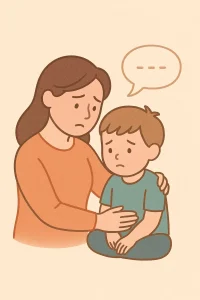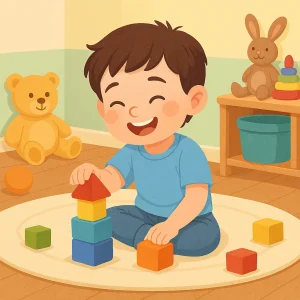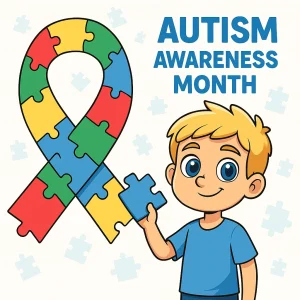Autism vs. Speech Issues: Understanding Social Pragmatic Disorder
Last Updated: May 17, 2024
Are you curious about the differences between Autism Spectrum Disorder (ASD) and Social Pragmatic Communication Disorder (SPCD)? You’re not alone. Both disorders can significantly affect communication and social skills, often leaving individuals and their families searching for answers. In this article, we will explore “Autism vs. Social Pragmatic Communication Disorder” to help you understand the differences and similarities between these two conditions.
It’s important to understand the distinction between ASD and SPCD because accurate diagnosis ensures individuals receive appropriate support and interventions. Both conditions share overlapping traits, particularly in communication and social interaction, yet they are distinct in their criteria and presentation.
Understanding Autism Spectrum Disorder (ASD)
Autism Spectrum Disorder (ASD) is a neurodevelopmental condition that affects communication, social interaction, and behavior. ASD is considered a spectrum because it encompasses a wide range of characteristics and severity levels, from mild to profound.
Read more: Social Communication Disorder: What You Need to Know
Key Characteristics of Autism Spectrum Disorder (ASD):
- Repetitive Behaviors: Individuals may engage in repetitive movements like twirling, rocking, or headbanging. They may also repeat certain words, phrases, or questions, which is known as echolalia.
- Fixation on Rituals and Routines: People with ASD often prefer consistent routines and may become distressed when there are unexpected changes. For example, insisting on eating the same food every day or following a strict schedule.
- Sensitivity to Sensory Stimulation: Many individuals have heightened sensitivity to stimuli such as bright lights, loud noises, or certain textures. This can lead to overstimulation and discomfort.
- Social Interaction Challenges:
- Lack of Eye Contact: Avoiding eye contact or finding it difficult to maintain is common.
- Difficulty Interpreting Facial Expressions: Understanding and responding to social cues can be challenging, leading to struggles with making friends or understanding others’ emotions.
Common Behavioral Signs of Autism Spectrum Disorder:
- Communication Difficulties: Delayed speech and language development, difficulty understanding gestures or humor, and challenges in maintaining conversations.
- Restricted Interests: Intense interest in specific topics like trains, maps, or numbers, often to the exclusion of other subjects.
- Social Challenges: Difficulties in forming peer relationships or understanding social norms.
Explore more about Speech Therapy for Autism and how it benefits individuals on the spectrum.
Understanding Social Pragmatic Communication Disorder (SPCD)
Social Pragmatic Communication Disorder (SPCD) is a communication disorder that primarily affects the social use of language. Individuals with SPCD struggle with adapting their communication to different social contexts, often finding it challenging to understand nonverbal cues or figurative language.
Key Characteristics of Social Pragmatic Communication Disorder:
- Trouble Adapting Communication Based on Context: Individuals may have difficulty adjusting their communication style to suit different social situations. For instance, they might not change their tone when speaking to different people or struggle to recognize when a conversation topic is inappropriate.
- Difficulty Understanding Nonverbal Cues and Figurative Language:
- Nonverbal cues like facial expressions, gestures, and body language can be confusing for those with SPCD.
- They may take figurative language literally, finding it difficult to understand sarcasm, metaphors, or idioms.
- Challenges with Gestures and Social Greetings:
- Difficulty using gestures like waving or pointing.
- They may not know how to greet others properly or maintain eye contact.
- Struggle in Maintaining Conversations and Friendships:
- Initiating and sustaining conversations is often a challenge.
- They may interrupt others frequently, change topics abruptly, or lose track of conversations.
- Building and maintaining friendships can be difficult due to these social communication challenges.
To understand how social communication disorders impact children, head to our guide on Social Communication Disorders.
Common Behavioral Signs of Social Pragmatic Communication Disorder (SPCD):
- Trouble Adapting Communication Based on Context:
- Difficulty adjusting language in different social situations.
- Struggles to recognize and respond to changing conversational norms.
- Difficulty Understanding Nonverbal Cues and Figurative Language:
- Confusion with body language, facial expressions, and gestures.
- Misunderstanding idioms, sarcasm, and metaphors.
- Challenges with Gestures and Social Greetings:
- Rarely uses gestures like waving or pointing.
- Difficulty with eye contact and social greetings.
- Struggle in Maintaining Conversations and Friendships:
- Interrupts conversations frequently or changes topics abruptly.
- Challenges in sustaining conversations and building friendships
Comparing Autism Spectrum Disorder (ASD) vs. Social Pragmatic Communication Disorder (SPCD)
Key Differences between Autism and Social Pragmatic Communication Disorder:
- Restricted/Repetitive Behaviors:
- ASD: Often includes restricted and repetitive behaviors like rocking, hand-flapping, and echolalia (repeating words/phrases).
- SPCD: Does not include repetitive behaviors, focusing solely on social communication challenges.
- Social and Communication Challenges:
- ASD: Involves both social interaction and communication challenges, such as avoiding eye contact, delayed language development, and difficulty interpreting facial expressions.
- SPCD: Focuses exclusively on social communication issues, such as conversation challenges, nonverbal cue difficulties, and adapting communication based on context.
- Diagnosis Process:
- SPCD: Often diagnosed after ruling out ASD due to the overlap in symptoms, particularly in social interaction challenges.
Comparing ASD and SPCD Traits
| Traits | Autism Spectrum Disorder (ASD) | Social Pragmatic Communication Disorder (SPCD) |
|---|---|---|
| Repetitive Behaviors | – Hand flapping, rocking, echolalia | – Not present |
| Restricted Interests | – Fixation on routines, topics | – Not present |
| Communication Skills | – Delayed speech, echolalia, eye contact avoidance | – Conversation challenges, nonverbal cue difficulties |
| Nonverbal Communication | – Struggles with gestures, facial expressions | – Trouble understanding gestures, facial expressions |
| Diagnosis | – Requires the presence of repetitive behaviors and restricted interests | – Diagnosed after ruling out ASD |
Understand the impact of autism on speech and communication in Speech and Language Difficulties Faced by Autistic Children.
Diagnosing Autism vs. Social Pragmatic Communication Disorder
Accurate diagnosis is crucial when distinguishing Autism Spectrum Disorder (ASD) from Social Pragmatic Communication Disorder (SPCD). Both conditions have overlapping symptoms, particularly in social communication challenges. However, the presence or absence of repetitive behaviors and restricted interests can help differentiate the two.
Diagnostic Criteria and Methods for ASD and SPCD:
- Developmental Screening Tools:
- Modified Checklist for Autism in Toddlers (M-CHAT):
A parent questionnaire that helps identify early signs of autism in toddlers. - Autism Diagnostic Observation Schedule (ADOS):
A standardized tool used by professionals to observe communication, social interaction, and play behavior. - Social Communication Questionnaire (SCQ):
Assesses communication skills and social functioning in children with suspected ASD or SPCD.
- Modified Checklist for Autism in Toddlers (M-CHAT):
- Observation in Various Settings:
- Observing a child’s behavior at home, in school, and in community settings provides insights into their communication and social interaction abilities.
- Clinicians look for signs like eye contact avoidance, conversation challenges, and nonverbal communication difficulties.
- Questionnaires and Interviews:
- Gathering detailed information from parents, teachers, and significant others is essential.
- Questionnaires may include the Vineland Adaptive Behavior Scale, Childhood Autism Rating Scale (CARS), and Social Responsiveness Scale (SRS).
- Language and Communication Assessments:
- Speech-language pathologists assess a child’s language abilities, nonverbal communication skills, and conversation challenges.
- Tools like the Clinical Evaluation of Language Fundamentals (CELF) and the Pragmatic Language Skills Inventory (PLSI) can identify specific communication issues.
Read more: Early Identification/ Warning Signs in child development
Importance of Accurate Diagnosis:
- Ensures individuals receive the appropriate support and intervention tailored to their needs.
- Early identification and intervention can significantly improve communication skills and quality of life.
- Misdiagnosis can lead to incorrect treatment strategies, delaying progress.
How Wellness Hub Can Assist:
At Wellness Hub, we understand the importance of an accurate diagnosis for Autism Spectrum Disorder and Social Pragmatic Communication Disorder. Our experienced team can connect you with qualified speech-language pathologists and relevant specialists for comprehensive assessments.
- Personalized Speech Therapy: Tailored to address specific social communication challenges associated with ASD and SPCD.
- Professional Guidance: We help you navigate the diagnostic process and find the right interventions for your loved one.
Treatment Approaches for Autism Spectrum Disorder (ASD)
When it comes to treating Autism Spectrum Disorder (ASD), a comprehensive approach tailored to individual needs is essential. Every individual with ASD presents a unique set of challenges and strengths, so treatments should be personalized. Here are some common treatment methods:
1. Behavior and Communication Treatments:
- Applied Behavior Analysis (ABA):
A widely-used therapeutic approach that focuses on reinforcing positive behaviors while reducing negative behaviors. It includes:- Discrete Trial Training (DTT): Breaking down skills into smaller tasks and using positive reinforcement.
- Pivotal Response Training (PRT): Targeting pivotal skills like motivation and self-management.
- Developmental, Individual Differences, Relationship-Based Approach (DIR/Floortime):
This approach emphasizes emotional and relational development. It focuses on building relationships through play and engagement while addressing sensory challenges. - Occupational Therapy:
Helps individuals with ASD develop sensory processing and motor skills. It also focuses on daily living skills like eating, dressing, and grooming. - Sensory Integration Therapy:
Designed to help individuals manage sensory input like touch, sound, and visual stimuli. Often beneficial for those with sensitivity to noisy or bright environments. - Speech Therapy:
Improves communication skills, both verbal and nonverbal. Techniques include articulation practice, social stories, and conversational skills training.
2. Dietary Approaches:
Some parents explore dietary changes to manage ASD symptoms, though it’s crucial to consult a doctor before starting any dietary approach.
- Gluten-free, casein-free diets have been explored but lack significant scientific evidence.
- Vitamin supplements may help fill nutritional gaps.
ASD Treatment Approaches
| Treatment Approach | Description |
|---|---|
| Applied Behavior Analysis (ABA) | Uses positive reinforcement to improve behavior. Techniques include discrete trial training, pivotal response training, and token economy systems aimed at reinforcing desirable behaviors and reducing unwanted behaviors. |
| DIR/Floortime | Builds relationships through play and sensory regulation. This approach focuses on meeting the child at their developmental level and building upon their strengths. Therapists and parents engage in activities that resonate with the child, promoting emotional and relational development. |
| Occupational Therapy | Develops motor and sensory skills, as well as daily living abilities. Occupational therapists work on fine motor skills, coordination, and sensory sensitivities, helping children gain independence in activities of daily living such as dressing, eating, and grooming. |
| Sensory Integration Therapy | Helps manage sensitivity to sensory stimuli. This therapy is designed to help children who experience problems with processing sensory information, such as touch, sound, and sight, which can affect their emotional and physical responses. |
| Speech Therapy | Improves communication and conversational skills. Speech therapists address challenges with speech, language, and communication by enhancing articulation, increasing vocabulary, and teaching appropriate conversational exchanges. |
| Dietary Approaches | Gluten-free diets and vitamin supplements (consult a doctor). Some parents report improvements in behavior and cognitive functions when specific dietary changes are implemented, although scientific evidence varies. |
To learn about the different therapies for ASD patients, check out our detailed article on Therapies Offered to Autistic Patients.
Treatment Approaches for Social Pragmatic Communication Disorder (SPCD)
Treating Social Pragmatic Communication Disorder (SPCD) involves tailored interventions that focus on improving social communication skills. Here are some common treatment methods:
1. Speech and Language Therapy:
Speech therapy is the cornerstone for managing SPCD. It includes:
- Role-playing and Modeling: Practicing different social scenarios like initiating conversations or taking turns.
- Conversational Skills: Enhancing the ability to start and maintain conversations.
- Nonverbal Communication: Recognizing and using facial expressions, gestures, and tone effectively.
2. Social Skills Training:
Helps individuals understand social norms and cues.
- Nonverbal Cues: Teaching recognition of facial expressions and body language.
- Social Stories: Using stories to help individuals learn appropriate social responses and behaviors.
- Group Sessions: Practicing social skills in a group setting.
3. Drama Therapy:
A creative approach to therapy, helping individuals explore communication through storytelling and enactment.
- Storytelling: Using stories to understand emotions, intentions, and perspectives.
- Role Play and Enactment: Encouraging individuals to step into different roles and practice social interactions.
- Safe Exploration: Creating a safe environment where individuals can explore challenging social situations.
4. Augmentative and Alternative Communication (AAC):
Provides alternative communication methods for those struggling with verbal expression.
- Symbols and Gestures: Using pictures, line drawings, or sign language.
- Communication Boards and Apps: Providing nonverbal individuals with tools to express themselves.
5. Video Modeling:
An evidence-based technique where individuals practice desired behaviors through video.
- Recording Successes: Filming the individual performing social tasks correctly and showing it back to them.
- Positive Reinforcement: Highlighting positive behaviors and removing prompts.
- Behavioral Practice: Encouraging the individual to replicate successful behaviors.
6. Parent and Caregiver Training:
Family involvement is crucial in reinforcing social communication skills outside therapy.
- Education and Training: Helping parents understand communication strategies and social norms.
- Coaching and Support: Providing guidance on how to create supportive environments at home.
- Practice Opportunities: Encouraging practice through games, role-playing, and daily conversations.
Read more about the importance of pragmatic language in Pragmatic Language Skills.
How to Tell the Difference Between Autism and Social Pragmatic Communication Disorder
It can be challenging to distinguish between Autism Spectrum Disorder (ASD) and Social Pragmatic Communication Disorder (SPCD) because both conditions involve social communication challenges. However, asking the right questions can help identify key differences.
Key Questions to Ask:
- Does the individual display repetitive behaviors (e.g., hand flapping, echolalia)?
- ASD: Repetitive behaviors, such as hand flapping, rocking, or echolalia (repeating words/phrases), are common in autism.
- SPCD: Individuals with SPCD do not exhibit repetitive behaviors.
- How does the individual respond to social cues and figurative language?
- ASD: Challenges in understanding social cues and figurative language are prevalent. Individuals may struggle with recognizing facial expressions, body language, and metaphors.
- SPCD: Also includes difficulty with nonverbal cues and figurative language but lacks other autism-specific traits like restricted interests.
- Are there significant challenges in nonverbal communication (e.g., eye contact, gestures)?
- ASD: Individuals often avoid eye contact, use fewer gestures, and struggle with facial expressions.
- SPCD: Nonverbal communication challenges are also present, particularly in gestures and eye contact.
Importance of Professional Diagnosis:
Given the overlap in social communication challenges, obtaining a professional diagnosis is crucial. Early intervention can significantly improve outcomes for both ASD and SPCD.
Why Seek Professional Guidance?
- Speech-Language Pathologists (SLPs):
Assess social communication skills and help identify whether challenges align more closely with ASD or SPCD. - Psychologists and Developmental Pediatricians:
Provide comprehensive evaluations, often using tools like the Autism Diagnostic Observation Schedule (ADOS) or Social Communication Questionnaire (SCQ). - Specialized Support at Wellness Hub:
At Wellness Hub, our Speech Therapy programs are tailored to meet individual needs, whether it’s for ASD or SPCD. We also provide guidance on seeking the right specialists and early intervention strategies.
Key Takeaways:
- Repetitive behaviors are a distinguishing feature of Autism Spectrum Disorder.
- Both ASD and SPCD involve challenges with social cues and figurative language.
- Early and accurate diagnosis is essential to receive appropriate support.
Conclusion
Specifically on challenges in social communication, like maintaining conversations and understanding nonverbal cues without the repetitive behaviors seen in ASD. Both disorders can appear similar, making professional advice essential for accurate diagnosis and effective treatment.
If you suspect you or someone you care about might have ASD or SPCD, reaching out to experts like speech-language pathologists or psychologists is a wise step. At Wellness Hub, we provide tailored programs in speech and occupational therapy designed to address these challenges. Our team is here to support you with personalized assessments and treatments that cater to individual needs, ensuring everyone has the opportunity to improve their communication skills and quality of life. For more information on how we can assist, visit our Speech Therapy page.
Frequently Asked Questions:
1. What is the difference between Autism Spectrum Disorder (ASD) and Social Pragmatic Communication Disorder (SPCD)?
Autism Spectrum Disorder (ASD) includes repetitive behaviors like hand flapping, rocking, and restricted interests, whereas Social Pragmatic Communication Disorder (SPCD) focuses solely on social communication challenges without the repetitive behaviors. ASD often affects both social interaction and communication, while SPCD is limited to social communication issues.
2. How is Social Pragmatic Communication Disorder diagnosed differently from Autism?
Social Pragmatic Communication Disorder (SPCD) is diagnosed after ruling out Autism Spectrum Disorder (ASD). Diagnostic tools include questionnaires like the Social Communication Questionnaire (SCQ), developmental screenings like the Modified Checklist for Autism in Toddlers (M-CHAT), and observations by speech-language pathologists and psychologists.
3. What are the common signs of Social Pragmatic Communication Disorder (SPCD)?
Common signs of SPCD include difficulty adapting communication based on context, challenges with nonverbal cues and figurative language, struggles with gestures and social greetings, and trouble maintaining conversations and friendships.
4. What are the repetitive behaviors associated with Autism Spectrum Disorder?
Repetitive behaviors associated with Autism Spectrum Disorder (ASD) include hand flapping, rocking, repeating words or phrases (echolalia), and fixation on rituals or routines.
5. Can Social Pragmatic Communication Disorder be mistaken for Autism?
Yes, Social Pragmatic Communication Disorder (SPCD) can be mistaken for Autism Spectrum Disorder (ASD) because both involve social communication challenges. However, unlike ASD, SPCD does not include repetitive behaviors or restricted interests.
6. How can Wellness Hub help with diagnosing and treating Autism and Social Pragmatic Communication Disorder?
Wellness Hub offers personalized Speech Therapy and Occupational Therapy programs designed to address the specific challenges of Autism Spectrum Disorder (ASD) and Social Pragmatic Communication Disorder (SPCD). Our team of experts provides comprehensive assessments, tailored treatment plans, and family support.
7. What are the treatment approaches for Autism Spectrum Disorder (ASD)?
Treatment approaches for Autism Spectrum Disorder (ASD) include Applied Behavior Analysis (ABA), Developmental, Individual Differences, Relationship-Based Approach (DIR/Floortime), Occupational Therapy, Sensory Integration Therapy, Speech Therapy, dietary changes, medication, and alternative treatments like Epsom salt baths.
8. How can speech therapy help individuals with Social Pragmatic Communication Disorder (SPCD)?
Speech therapy can help individuals with Social Pragmatic Communication Disorder (SPCD) by improving their conversational skills through role-playing and modeling, teaching them how to interpret nonverbal cues, and enhancing their ability to use gestures and social greetings appropriately.
9. Why is early diagnosis important for Autism and Social Pragmatic Communication Disorder?
Early diagnosis is crucial for Autism Spectrum Disorder (ASD) and Social Pragmatic Communication Disorder (SPCD) because it allows for timely intervention. Early intervention can significantly improve social communication skills, daily living abilities, and overall quality of life.
10. Can parents or caregivers help support children with Social Pragmatic Communication Disorder at home?
Yes, parents and caregivers can support children with SPCD at home by learning communication strategies through training and coaching. Involving family in practicing social greetings, role-playing conversations, and creating supportive environments can make a positive difference.
About the Author:
Anuradha Karanam
Speech-language pathologist (7+ years of experience)
Anuradha Karanam is a skilled speech-language pathologist with over 6 years of experience. Fluent in Tamil, Telugu, Hindi, and English, she specializes in parent counseling, speech sound disorders, fluency assessment, and speech-language evaluations. Anuradha excels at working with children with developmental disorders, offering creative and effective therapy programs. Currently, at Wellness Hub, she holds a BASLP degree and is registered with the RCI (CRR No A85500). Her patience, ambition, and dedication make her a trusted expert in her field.
Connect with Anuradha to learn more about how she can help you or your loved one find their voice.
Book your Free Consultation Today
Parent/Caregiver Info:
Client’s Details:
* Error Message








